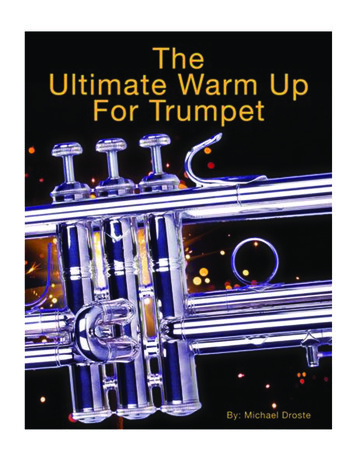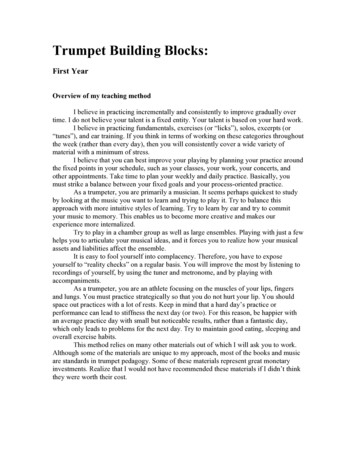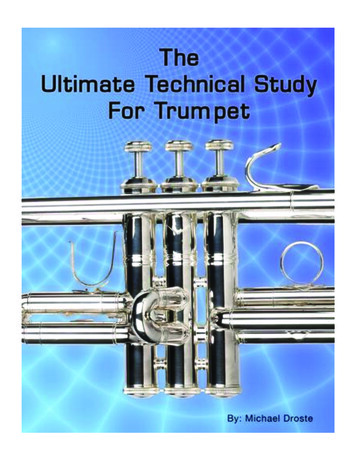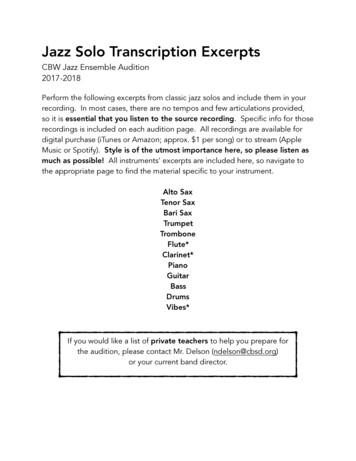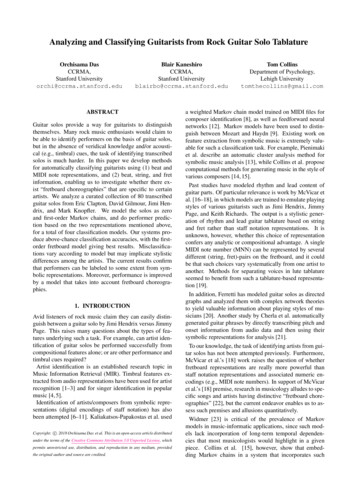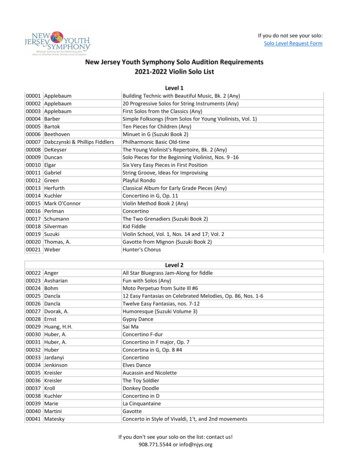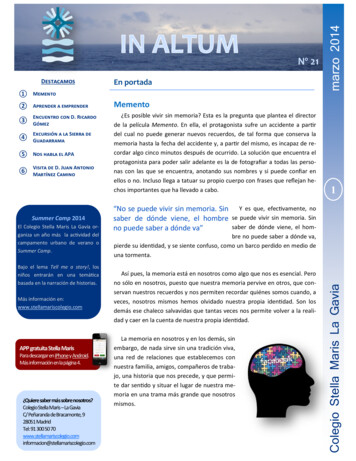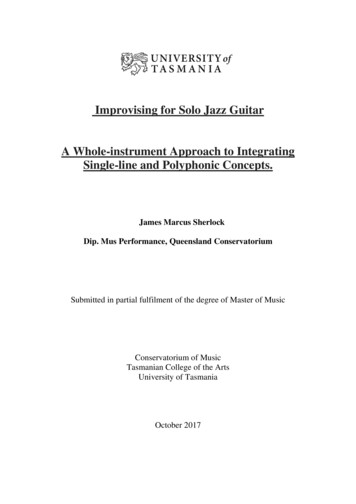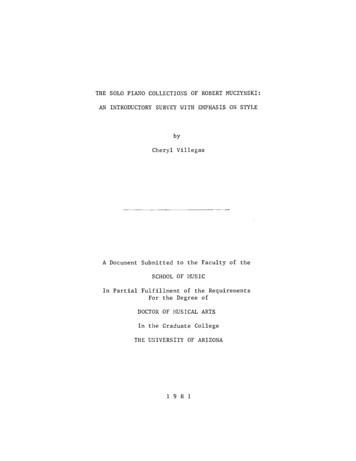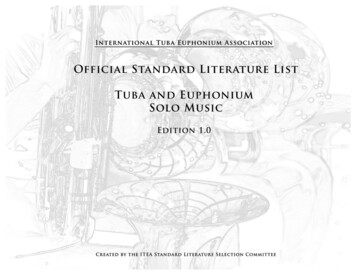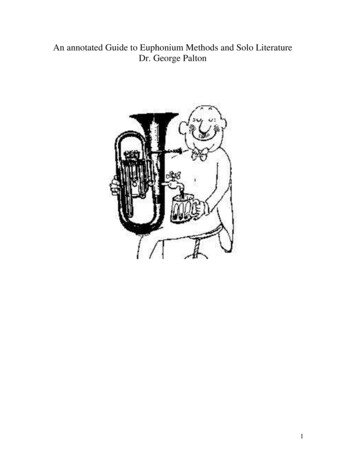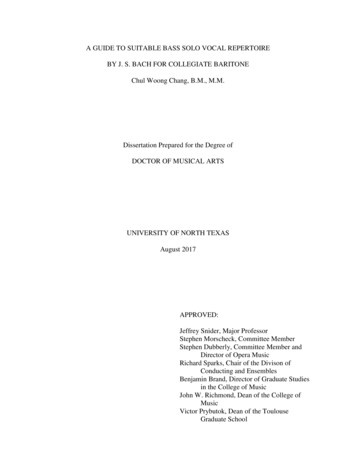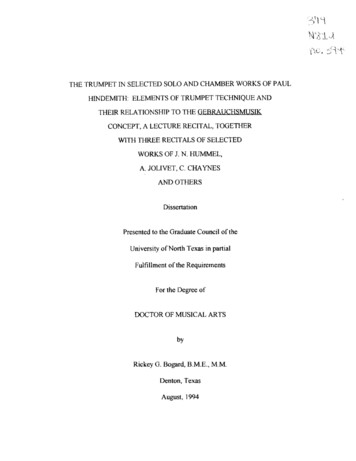
Transcription
3*1 i' f \ c . iHH'-THE TRUMPET IN SELECTED SOLO AND CHAMBER WORKS OF PAULHINDEMITH: ELEMENTS OF TRUMPET TECHNIQUE ANDTHEIR RELATIONSHIP TO THE GEBRAUCHSMUSIKCONCEPT, A LECTURE RECITAL, TOGETHERWITH THREE RECITALS OF SELECTEDWORKS OF J. N. HUMMEL,A. JOLIVET, C. CHAYNESAND OTHERSDissertationPresented to the Graduate Council of theUniversity of North Texas in partialFulfillment of the RequirementsFor the Degree ofDOCTOR OF MUSICAL ARTSbyRickey G. Bogard, B.M.E., M.M.Denton, TexasAugust, 1994
3*1 i' f \ c . iHH'-THE TRUMPET IN SELECTED SOLO AND CHAMBER WORKS OF PAULHINDEMITH: ELEMENTS OF TRUMPET TECHNIQUE ANDTHEIR RELATIONSHIP TO THE GEBRAUCHSMUSIKCONCEPT, A LECTURE RECITAL, TOGETHERWITH THREE RECITALS OF SELECTEDWORKS OF J. N. HUMMEL,A. JOLIVET, C. CHAYNESAND OTHERSDissertationPresented to the Graduate Council of theUniversity of North Texas in partialFulfillment of the RequirementsFor the Degree ofDOCTOR OF MUSICAL ARTSbyRickey G. Bogard, B.M.E., M.M.Denton, TexasAugust, 1994
/A ///*U C-Bogard, Rickey G., The Trumpet in Selected Solo and Chamber Works of PaulHindemith: Elements of Trumpet Technique and Their Relationship to theGebrauchsmusik Concept. A Lecture Recital, Together with Three Recitals of SelectedWorks of J. N. Hummel, A. Jolivet, C. Chaynes and Others. Doctor of Musical Arts(Performance), August, 1994, 106 pp., 56 musical examples, bibliography, 52 titles.Paul Hindemith was unquestionably one of the most important composers of thetwentieth century. He was internationally acclaimed as a performer, composer, andteacher. His theory and composition books are landmarks in theoretical study, and hiscompositions encompass every genre from solo and chamber to opera and symphonicworks.Hindemith was one of the first twentieth-century composers to utilize windinstruments extensively in his chamber music. While Post-Romantic composers beforehim preferred strings and piano in their chamber music, Hindemith achieved a moreextensive palette of instrumental colors by including at one time or another most of thewind instruments. His inclusion of winds is all the more extraordinary in that heproduced a solo work for every major orchestral wind instrument.The trumpet was one of the wind instruments Hindemith used frequently in hischamber music, and he employed it prominently in five works from 1925 to 1954. Theseworks are the Sonate fur Trompete (1939), the Konzert fur Trompete in B und Fagott mitStreichorchester (1954). Drei Stucke (19251 the Septett fur Blasinstrumente (1949), and"Morgenmusik," from the collection Ploner Musiktag (1932). This study examines andcompares Hindemith's writing for the trumpet in these selected works, noting features inhis use of the instrument which determine the applicability of the works to theGebrauchsmusik concept.
Hindemith's concern for making his works playable in part reflects his philosophyof composition embodied by the term Gebrauchsmusik. This term is not used exclusivelyin connection with Hindemith's music, but is often used by historians to explain theidiomatic writing in evidence in his compositions compared to the more abstract andtechnically demanding works of his contemporaries. Gebrauchsmusik is defined asmusic intended for practical use by amateurs, as opposed to virtuosic music conceivedfor the professional player. From about 1927, Hindemith committed a period of hiscompositional output to music of this nature, which he preferred to call Sing und SpielMusik. Works from this group are briefly considered to determine the elements whichextend their accessibility to amateurs.
ACKNOWLEDGMENTSThe completion of the doctoral degree reflects the selfless efforts of manyindividuals. I wish to thank University of North Texas faculty members Dr. DeannaBush and especially Dr. Rosemary Killam for their instruction and guidance. Myappreciation is extended to Professor John J. Haynie, for his invaluable lessons on musicand life. Special thanks are due my Major Professor, Dr. Leonard Candelaria. Hisenergetic efforts on my behalf have allowed the completion of the degree, and hismusical excellence is a source of inspiration.I am greatly endebted to Claudia Moorehead for her assistance in translation, andto my colleagues and students at the University of Texas at Arlington who have offeredencouragement.Sincere appreciation is due my family. My parents, Bobby and Melba Bogard,have supported my every effort and motivated me to persevere. Finally, my wife Kathyand my daughter Lauren have endured with me every step of the doctoral process withencouragement, exceeding patience, and tireless assistance.It is to these people that I dedicate my work.11
Tape recordings of all performances submitted as dissertation requirements areon deposit in the University of North Texas Libraryin
TABLE OF CONTENTSACKNOWLEDGMENTSiiLIST OF EXAMPLESixChapterI. INTRODUCTION, PAUL HINDEMITH BIOGRAPHY,AND BACKGROUND INFORMATION1II THE SONATA FOR TRUMPET AND PIANO:THE TRUMPET AS A SOLO INSTRUMENT24III. THE CONCERTO FOR TRUMPET. BASSOON.AND STRINGS:THE TRUMPET AS A DUO INSTRUMENT48IV. MORGENMUSIK. DREI STUCKE. ANDTHE SEPTET FOR WIND INSTRUMENTS:THE TRUMPET IN CHAMBER MUSIC68V. CONCLUSIONS94BIBLIOGRAPHY103IV
North Texas State UniversitySchool of MusicpresentsRICK BOGARDin aGraduate Trumpet RecitalAssisted byElizabeth Seidel, PianoHerman Hess, OrganMonday, June 27,19836:15 p.m.Sonate de ConcertAllegro moderateModerateAllegro non troppoAllegretto scherzandoConcert HallAlessandro Stradella(Piccolo trumpet in A)Concerto(1644-1682)Charles ChaynesModeratoAdagioAllegro AriaFinale(1903-Sonatine)Bertold HummelBewegtLangsame AchtelZiemlich lebhaftPresented in partial fulfillment of therequirements for the degreeDoctor of Musical Arts(1925-)
North Texas State UniversitySchool of MusicpresentsRICK BOGARDin aGraduate Trumpet Recitalassisted byDonna Tan-MeineckeMonday, June 25, 19846:30 p.m.Suite in D Major (1733)Concert HallGeorge Frideric Handel(Piccolo trumpet in A)OvertureGigueMenuettoBoureeMarchConcerto (1953)Wayne R. BohrnstedtBrisklySlowlySpiritedIntermissionSonata (1963)Thomas BeversdorfAllegro decisivoLargoAllegroCaprice (1943)Eugene Bozza(C trumpet)Presented in partial fulfillment of therequirements for the degreeDoctor of Musical ArtsVI
University of North TexasCollege, of hmpresentsA Graduate RecitalRICK BOGARD, trumpetassisted byLinda Booth, pianoMonday, April 12, 19936:30 p.m.Concert HallSinfonia in D (G-l)ModerateAllegroGraveAllegroGiuseppi Torelli(1658-1709)Concertino. Andr6 Jolivet(1905-1974)- Intermission -Concerto in E-flatAllegro con SpiritoAndanteRondoJohann Nepomuk Hummel(1778-1837)Parable XIVVincent Persichetti(1915-1987)CapriceJoseph Turrin(b. 1947)Presented in partial fulfillment of therequirements for the degree ofDoctor of Musical ArtsVll
University of North TexasCok(jiof hs&presentsA Graduate Lecture RecitalRICK BOGARD, trumpetassisted byKathryn Fouse, pianoBobby Francis, conductorGrant Peters, trumpet Jill Rodriguez, horn Efrain Sain, tromboneJoseph Boylan, tuba Jackie Akin, flute Rogene Russell, oboeKen Krause, clarinet Forest Aten, bass clarinet Paul Stebbins, bassoonMonday, April 25, 19945:00 pmRecital HallThe Trumpet in Selected Solo and Chamber Works ofPaul HIndemith: Elements of Trumpet Technique and theirRelationship to the Gebrauchsmugik ConceptMorgenmusik, from Ploner Musiktag (1932)Massig BewegtPaul HindemithLiedBewegtSonata for Trumpet (1939)Mit KraftMassig BewegtTrauermusik Sehr LangsamPaul HindemithSeptet for Wind Instruments (1948)I. LebhaftIII. VariationenV. Fuge Alter Berner MarschPaul HindemithPresented in partial fulfillment of therequirements for the degree ofDoctor of Musical Artsvm
LIST OF EXAMPLESExamplePage1. Handwritten notation on title page of Hindemith's Sonata for Trumpet262. Hindemith Sonata for Trumpet. 1st movement, Theme A,measures 1-9273. Hindemith Sonata for Trumpet. 1st movement, Theme B,measures 30-36284. Hindemith Sonata for Trumpet. 1st movement, Theme C,measures 47-54285. Hindemith Sonata for Trumpet. 1st movement, Theme A,measures 67-78296. Hindemith Sonata for Trumpet. 1st movement, Minor second andperfect fourth, measures 137-142297. Hindemith Sonata for Trumpet. 2nd movement, measures 1-58. Hindemith Sonata for Trumpet. 2nd movement, B section,measures 27-309. Hindemith Sonata for Trumpet. 2nd movement, B section trumpet motive 1,measures 52-5730303110. Hindemith Sonata for Trumpet. 2nd movement, B section trumpet motive 2,measures 43-463111. Hindemith Sonata for Trumpet. 2nd movement, A' section,measures 59-693212. Hindemith Sonata for Trumpet. 2nd movement, Conclusion,measures 77-873213. Hindemith Sonata for Trumpet. 3rd movement, Opening trumpet motivemeasures 7-123314. Hindemith Sonata for Trumpet. 3rd movement, 2nd theme,measures 26-3134IX
15. Hindemith Sonata for Trumpet. 3rd movement, A' section,measures 51-543516. Hindemith Sonata for Trumpet. 3rd movement. A'section,measures 58-643517. Hindemith Sonata for Trumpet. 3rd movement, Chorale, Alle Menschenmussen sterben3618. Hindemith Concerto for Trumpet. Bassoon, and Strings. 1st movement.1st theme, measures 1-95219. Hindemith Concerto for Trumpet. Bassoon, and Strings. 1st movement.Motive from 1st theme, measures 11-16.,,,5320. Hindemith Concerto for Trumpet. Bassoon, and Strings. 1st movement.2nd theme, measures 30-345321. Hindemith Concerto for Trumpet. Bassoon, and Strings. 1st movement.Descending eighth note motive, measures 51-535422. Hindemith Concerto for Trumpet, Bassoon, and Strings, 1st movement,Development section, measures 63-665423. Hindemith Concerto for Trumpet. Bassoon, and Strings. 1st movement.2nd theme statement in trumpet, measures 113-1165524. Hindemith Concerto for Trumpet. Bassoon, and Strings. 1st movement.Conclusion, measures 195-1965625. Hindemith Concerto for Trumpet. Bassoon, and Strings. 2nd movement,1st theme, measures 2-75726. Hindemith Concerto for Trumpet, Bassoon, and Strings. 2nd movement,2nd theme, measures 18-235727. Hindemith Concerto for Trumpet. Bassoon, and Strings. 2nd movement,3rd theme, measures 31-395828. Hindemith Concerto for Trumpet. Bassoon, and Strings. 2nd movement,4th theme, measures 59-6358
29. Hindemith Concerto for Trumpet. Bassoon, and Strings. 3rd movement,1st theme, measures 1-75930. Hindemith Concerto for Trumpet. Bassoon, and Strings. 3rd movement,Trumpet and Bassoon in minor sevenths,measures 33-386031. Hindemith Concerto for Trumpet. Bassoon, and Strings. 3rd movement,measures 51-566132. Hindemith Concerto for Trumpet. Bassoon, and Strings. 3rd movement,Imitation in final A section,measures 71-746133. Hindemith Concerto for Trumpet. Bassoon, and Strings. 3rd movement.Imitation in final A section,measures 78-826134. Hindemith Morgenmusikr 1st movement, Principal motive,measures 1-37135. Hindemith, Morgenmusik. 2nd movement, Principal motive,measures 1-37136. Hindemith, Morgenmusik. 3rd movement, Principal motive,measures 1-57137. Hindemith Morgenmusik. 3rd movement, Trumpet call motive,measures 24-287238. Hindemith Morgenmusik. 3rd movement, hemiola figure,measures 15-197339. Hir1,1st movement, 1st theme,measures 1-7.40. Hindemith Dreimeasures 8-15.77i, 1st movement, 2nd theme,78XI
42. Hindemith Drei Stucke. 2nd movement, Trumpet figure,measure 97943. Hindemith Drei Stucke. 3rd movement, Theme,measures 1-67944. Hindemith Drei Stucke. 3rd movement, Variation 3,measures 13-188045. Hindemith Drei Stilcke. 3rd movement, Variation 5,measures 31-368046. Hindemith Drei Stucke. 3rd movement, Variation 10,measures 72-778047. Hindemith Septet. 1st movement, 1st thememeasures 1-68448. Hindemith Septet. 1st movement. 2nd theme,measures 27-348549. Hindemith Septet. 1st movement, 3rd theme,measures 58-618550. Hindemith Septet. 1st movement. Second theme inaugmentation, measures 96-1038551. Hindemith Septet. 1 st movement, 3rd theme in trumpet,measures 152-1558652. Hindemith Septet. 3rd movement, Theme in trumpet,measures 1-48653. Hindemith Septet. 5th movement, First fugue theme,measures 1-78754. Hindemith Septet. 5th movement, Second fugue theme,measures 38-438855. Hindemith Septet. 5th movement. Third fugue theme,measures 73-7588Xll
56. Hindemith Septet. 5th movement, March theme,measures 104-121xm89
Notes referred to in the text are in concert pitch, regardless of the pitch of theinstrument involved. The octave designation follows the pattern employed in The NewHarvard Dictionary of Music, in which the middle C on the piano keyboard is designatedc', with the other octaves designated as follows:C,Ccc'c"c'"c'tmFor the purposes of this paper, the trumpet range has been divided into three parts,based on whether the notes are below the treble clef staff, within the staff, or above thestaff. Low range: e to d'; middle range: e-flat' to f-sharp"; high range: g" to b-flat".xiv
CHAPTER IINTRODUCTION, PAUL HINDEMITH BIOGRAPHY, ANDBACKGROUND INFORMATIONIntroductionPaul Hindemith was unquestionably one of the most important composers of thetwentieth century. He was internationally acclaimed as a performer, composer, andteacher. His theory and composition books are landmarks in theoretical study, and hiscompositions encompass every genre from solo and chamber to opera and symphonicworks.Hindemith was one of the first twentieth-century composers to utilize extensivelywind instruments in his chamber music. While Post-Romantic composers before himpreferred strings and piano in their chamber music, Hindemith achieved a more extensivepalette of instrumental colors by including at one time or another most of the windinstruments. His inclusion of winds is all the more extraordinary in that he produced asolo work for every major orchestral wind instrument. Not even the tuba, an instrumentrarely favored with solo works by other composers of Hindemith's stature, wasoverlooked.The trumpet was one of the wind instruments Hindemith usedfrequentlyin hischam
Concerto Charles Chaynes Moderato (1925- ) Adagio Allegro giocoso Intermission Sonata FlorPeeters Allegro (1903- ) Aria Finale Sonatine Bertold Hummel Bewegt (1925- ) Langsame Achtel Ziemlich lebhaft Presented in partial fulfillment of the requirements for the degree Doctor of Musical Arts . North Texas State University School of Music presents RICK BOGARD in a Graduate Trumpet Recital .Author: Rick BogardPublish Year: 1994
